
Once again, I’ve been hanging out on my deck upon returning from the office on this fine, sunny Thursday afternoon, and got right down to business: fixing a drink, and checking out interesting old rolling stock online, on the fb group, Finding Future Classic Cars.
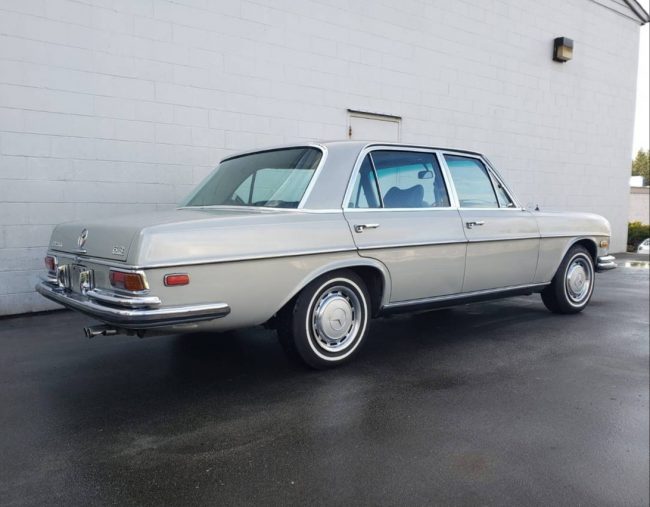
Today’s set of wheels is perhaps as far away from the ’71 Ambassador as you can get, but like the Kenosha Cadillac, I love it. To wit: Mercedes’s early ’70s hot rod, the 300 SEL 6.3.

Upon first glance, it appears to just be another late ’60s/early ’70s W108/W109 sedan.

But beneath the somewhat plain but elegant flanks lurks a Frankenstein’s monster: the 386 CID, 6.3 liter V8 from the ‘Grosser’ Mercedes 600 sedans, favored by Dr. Evil, Idi Amin and Ernst Stavros Blofeld, to name but a few.
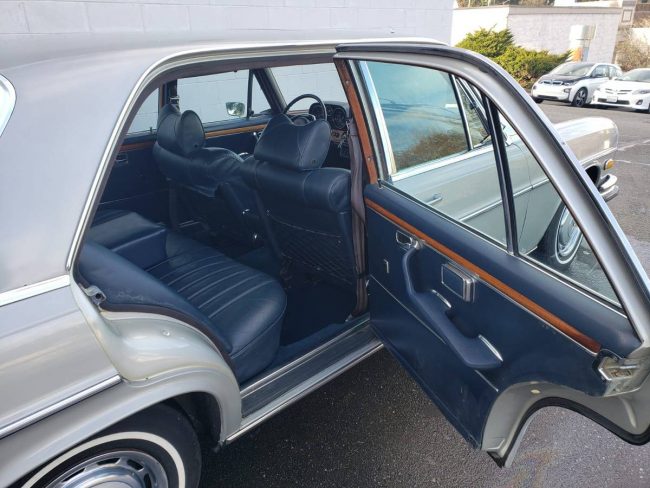
These are my favorite Mercedes sedans, I like the Swinging Sixties look, the color keyed wheel covers, genuine wood trim inside, stacked quad headlamps, and those cat-eared headrests.
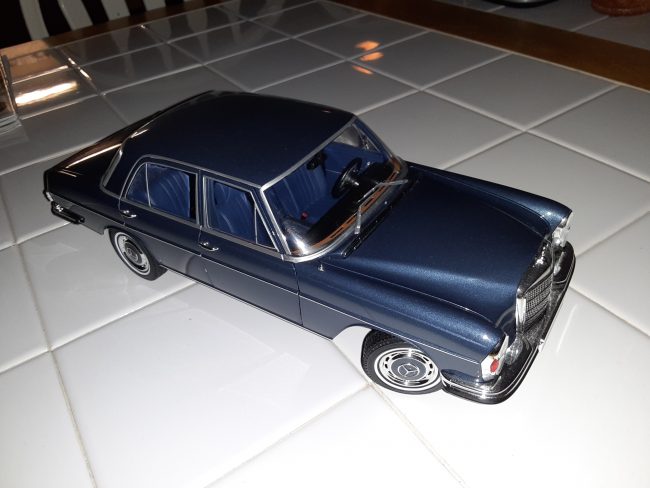
Enough so that I had to purchase this highly detailed 1/18 scale version by Norev a few years back. But I digress.
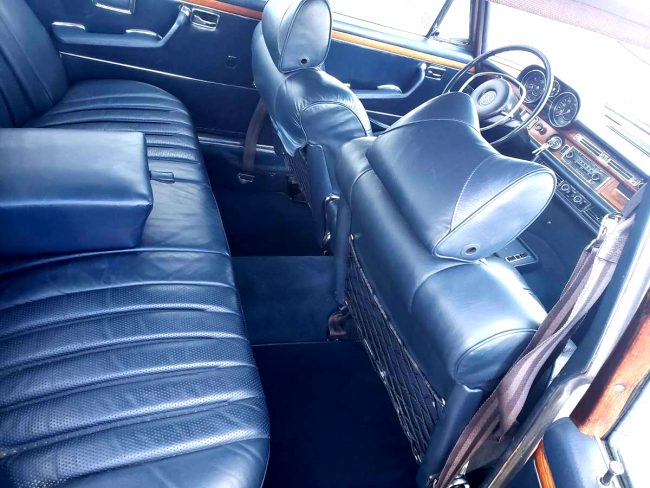
Anyway, as the story goes, in the late Sixties Erich Waxenberger, who worked in Mercedes’s experimental department, stuck the 600’s V8 into a long wheelbase W109 300. It barely fit. After some other bigwigs tried it out, it eventually went into production.
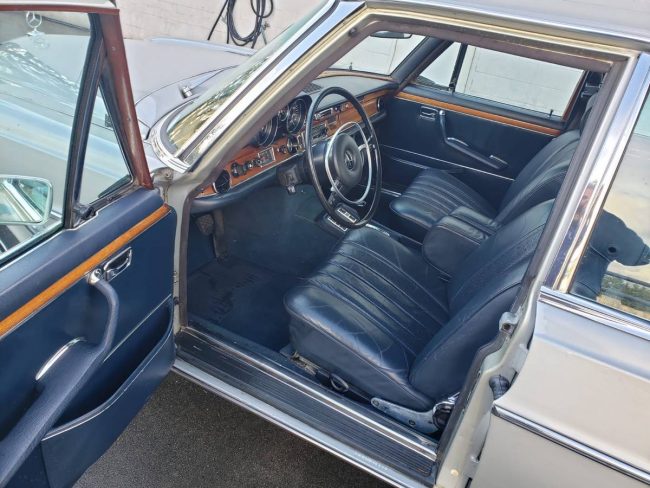
And it was fast. 300 hp, 0-60 in 6.9 seconds, and it would stay nearly even with a contemporary Lamborghini Miura in the quarter mile. Pretty dam good for a 4,000 lb. German luxocruiser. 6,526 were built.
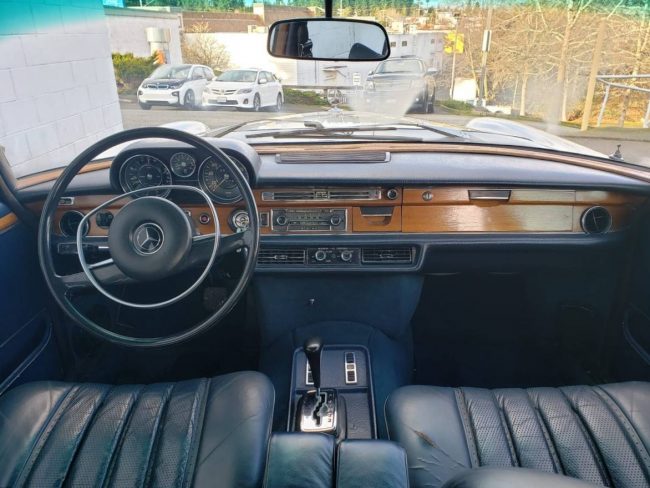
This one is currently on craigslist for a cool $26,500. Though in the text it also says ‘25,000 FIRM,’ so who knows. I do know these have all sorts of expensive little components.
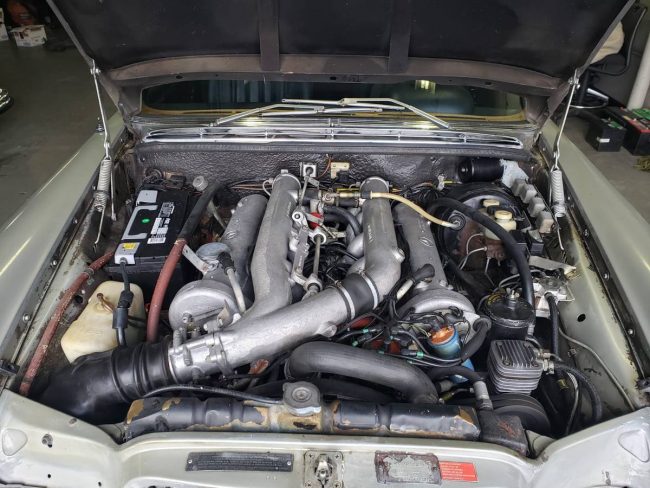
Though from the ad this one seems to be in decent, if not spectacular, shape: “The car recently came out of long term storage…recent work: Serviced fuel pump. Flushed gas tank and replaced rubber fuel hoses. Cleaned clogged metal fuel lines. Replaced fuel filter & gasket. Installed new battery. Lubricated air suspension lines. Serviced front brake calipers. Changed engine oil, transmission and power steering fluids. The air suspension raises in about 8 minutes (ED: eight MINUTES?!) and goes down when the engine is turned off in about 20 minutes.”
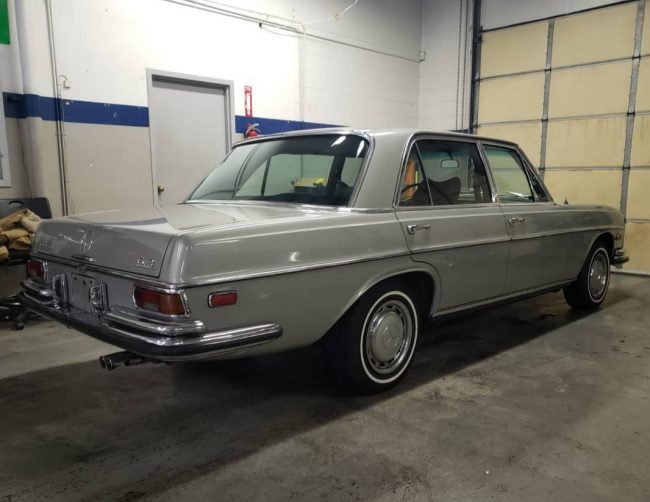
“There are a few scratches on the hood. Some surface rust above rear right wheel. The undercarriage is for the most part is clean with minimal rust if any…car comes with a jack , spare tire and a manual book. The glass, chrome trim, leather seats are in a very good shape considering the age of the car. The wood as evident in the images is also in a good condition with some shine to it. The paint looks good from about 20 feet. A paint job is recommended. The sunroof is in a good working condition. I highly recommend and encourage an inspection.”
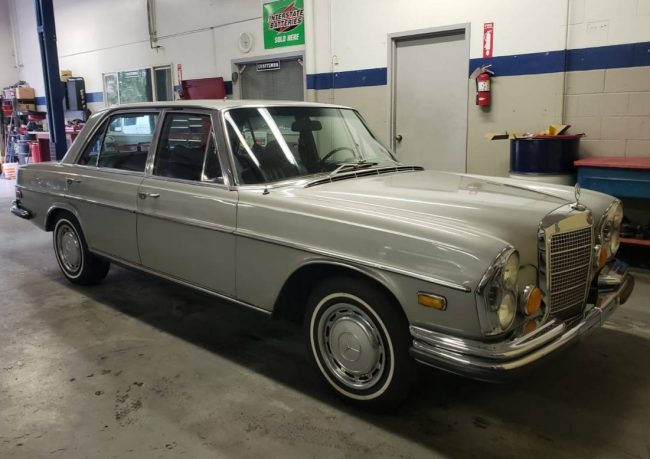
Still, this is a rare and desirable car…but be prepared to pay to make it fully sorted. Good news: M-B makes EVERYTHING, to this day, that this car may need. Bad news: hope you’re filthy stinking rich, ha ha.

Still, it’s a beautiful car, and I love the silver with the navy blue leather. So ifin you’re so inclined, and have lots of disposable income, check out the ad here. As for me, I’m perfectly content with my scale model, period brochures, and Mercedes books!
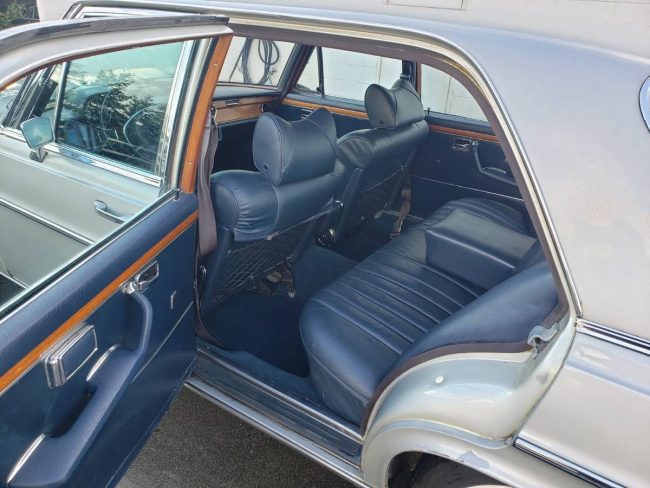







24 Comments
GAURANTTED it needs AT LEAST $4,000.00 worth or air suspension repairs before you can test drive it .
Yes, this is a fantastic car but, it was almost certainly parked because it needed $5,000.00 + worth of air bag repairs just to begin .
“rusty fuel lines” ?! _RUN_AWAY_FAST ,
I’m an old M-B FanBoi but this is a money pit .
-Nate
When these cars were old but not yet classics, were there kits to change out the air bags to coils as on some Panther Lincolns?
I don’t know having been warned away from them before I could make a mistake and buy one .
-Nate
I would never cheap out like this, I wouldn’t on a Panther (the correct parts to maintain the air ride are dirt cheap), but it would be particularly blasphemous on something like this!
Yep, if I really wanted one of these, I’d rather have a contemporary 280SE with the six and normal suspension.
Absolutely gorgeous. I really hope this stunning piece of kit ends up in good hands
Nice car, but the maintenance requirements and costs on these are legendary.
If I was going to take that kind of plunge I think I’d stick to sports cars (or maybe an old Bentley).
Silver with blue leather is such a good looking combination, much warmer than the stark black interior ever car these days seems to have.
It is so interesting to me that MB displaced their inline six for their big block grosser V8s in these. It is almost like they are admitting that Americans are correct, that more is more. Of course it could be that they were only pandering for an American pay day. What percentage were sold in the USA?
Nothing wrong with a V-8 for compact and relatively light source of power, but of course Europeans have always taxed displacement and/or fuel heavily, which is why V-8s were rare outside of the USA. Certainly MB engineers and many of their customers have always appreciated power, but they achieved it with more than just punching bigger holes in the block by also adding OHC and FI, which took the Americans another 20 years and CAFE to follow. The disadvantage come 20+ years later for the collector, because it is certainly a lot cheaper to rebuild a 500 ci Cadillac V-8 (and its hay wagon suspension) than the sophisticated motor and suspension of one of these.
Remember though, the Grosser engine wasn’t designed for highway top speed like their sixes. It was instead trying to match Rolls big blocks. Notice the 6.3 went to 6.9 just after RR went from 6.25 to 6.75 liter on their V8. This wasn’t a high output version just the limo engine. Put in the smaller body, it was acceleration that went through the roof. Not a bad thing at all, just not very German.
Smooth lazy power (waftability) is hard to achieve with anything but large displacement, especially when trying to minimize jerky shifting that can upset the smooth ride, but such size also brings thirst that is very painful unless you have world leading paychecks and low car related taxes that US citizens have almost uniquely enjoyed. Only really rich Europeans could afford a big engined car, and their sheer wealth and price insensitivity is perhaps the reason the British, German, and Italian elite brands tended to favor the V-12 configuration that is even smoother than a V-8, but lighter and more easily packaged than the also extremely smooth straight 8 favored by so many American brands until the mid-1950s.
The German (and European) preferences for high top speed is also understandable given their much better and earlier high speed autobahns, autostrade, and autoroutes that were not only built for speed with little or no speed limits, but also had light traffic until at least the 1970s. Who cares about a fast quarter-mile when you can legally cruise along at 90+ mph? And of course if you can do that you also care about decent brakes, stable handling (especially at high speed), accurate steering, and engines that will still get reasonable MPG and won’t melt down during sustained high speeds, which is why the Europeans tended to be superior in those characteristics than US cars.
High speed Autobahn. Yes. Much better Autobahn(compared, maybe, to our Interstates?). Hardly. The Autobahn is notorious for two things-legal high speeds and poor, pot holed road surface. The ideal car for the Autobahn? Something like an aluminum Military Hummvee suspension and platform with a 300SEL 6.3 powertrain.
There was no catch-up with Rolls-Royce during the period. The 600 was 25% more expensive than a Rolls-Royce, and it was far more advanced and luxurious. There was no performance rivalry even when the Rolls had a bigger engine, although one lacking fuel injection, overhead cams, or enough power to advertise a rating. Both engines grew because unleaded gas meant lower compression ratios and diminished performance. Trying to match Rolls-Royce? You should read some comparison tests from the day. Rolls-Royce couldn’t match Detroit, and the Mercedes-Benz 600 could only be faulted for price.
I think you are foolishly comparing the 600 to the Silver Shadow rather then the hand made by Mullliner or occasionally James Young Phantom in price. Do you think that MB just happened upon 6.3 liters after the previous pontoon Adenaur limos tried to get by on the mass market 3.0 liters.
Yes I am sure your road tests made “informed” judgements on limos based on skidpad performance and thought zero of the gross mobsters and third world dictators piling into the back of their Grossers. Good for MB to charge them a full price, as having them as owners was otherwise only a way to become soiled
Comparing a Phantom V to a 600 is like comparing a party bus to the presidential limousine. Phantoms were antiques, and they weren’t even all that great to be driven in by post-war standards. Even the English knew Cadillacs were better than Phantoms by the time the 600 came along.
The Phantom VI was still a 4 wheel drum brake car leaf sping car when the last one stumbled off the assembly line in 1990, I think, it might have been the last new 4 wheel drum car ever?
The end if the Phantom VI in 1992 left the world of limos to the cut and shut jobs. 4 wheel discs are barely any solace as the real party buses began to feature fireplaces and stripper poles instead of the ability to arrive with dignity as originally imagined by Lord Brougham and reached it’s zenith under Harry Grylls..
The last round of Phantom revisions in 1977 were timed with QEII’s Silver Jubilee. For her Diamond Jubilee in 2002, Bentley was asked to do up something special, and Bentley’s German chief designer responded with 2 state limos that looked a little like the old. No doubt Her Majesty was “thrilled” the engine was now turbocharged. Of course even this barest of nods to such a glorious tradition did not inspire the foreigners at the helm to offer a few hand made one offs to a few discerning clients They were too busy in Leipzig.
This car is actually an eclectic mix of advanced and antique features for its day. The engine was certainly packed with modern specifications, and the air ride appeals to people who’ve never owned one. At the same time, this car didn’t just have treacherous and primitive swing-axle IRS, it also had a front suspension without ball joints. Lincoln started using them in 1952, but this thing had great brakes and a large displacement V8 attached to a pre-war chassis. When Mercedes replaced this car with the W116, they advanced their chassis design to 1960’s standards and incorporated passive safety. Then they spent the next twenty years trying to figure out how to get back to the ride and noise isolation levels achieved by their antiques.
Good point – Jaguar, BMW, and even Rolls Royce (Shadow) were well ahead of these when it comes to suspension sophistication.
Not exactly the same car, but close enough:
https://www.youtube.com/watch?v=hhji2cMdAgQ
Oh, the humanity.
(insert bad joke about $4000 air bag repairs and Susan Sarandon)
Did anyone ever make a successful air suspension? I passed on a pristine Jaguar due to the air lights lit up (among others). The air struts seemed non repairable (unlike the transit buses I used to work on) and conversion to springs also seemed way out of line. Probably for the best….
They are all successful in terms of offering a pillow ride and being trouble free during the warranty or lease period, none are successful as they move into middle-age.
Extremely cool car. Jack posted a review of one of these back on the old site a few years back: https://www.thetruthaboutcars.com/2010/07/capsule-review-mercedes-benz-300sel-6-3/